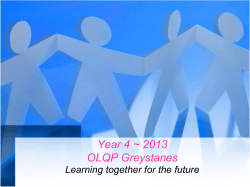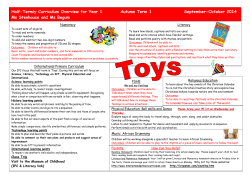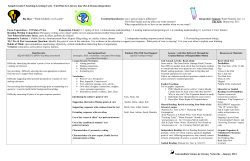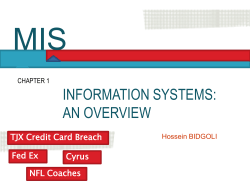
Carmondean Primary School SCHOOL IMPROVEMENT PLAN 2014-2015
Carmondean Primary School SCHOOL IMPROVEMENT PLAN 2014-2015 DATA LABEL-PUBLIC 1 Healthy Achieving Included Active Respected Safe Responsible Nurtured Learning and Teaching Successful Learner Confident Individual Responsible Citizen Effective Contributor Vision and Leadership Culture and Ethos People Partnership DATA LABEL-PUBLIC 2 The West Lothian Context West Lothian Council is committed to delivering the best possible outcomes for children and young people so that they have the best start in life and are ready to succeed by following the principles of Curriculum for Excellence (CfE) and Getting it Right for Every Child (GIRFEC). Within Curriculum for Excellence, every child and young person is entitled to experience a curriculum which is coherent from 3-18. Those planning the curriculum have a responsibility to work in partnership with others to enable children and young people to move smoothly between key transition points, building on prior learning and achievement in a manner appropriate to the learning needs of the individual. This should ensure that young people are well placed to move into positive destinations and adult life. The Corporate Plan sets the strategic direction and our priorities for West Lothian Council. There are eight priorities that we, and our community, believe can make a lasting and sustainable impact on the local area and improve the lives of residents in West Lothian. Priority 1: Delivering positive outcomes and early interventions for early years Priority 2: Improving the employment position in West Lothian Priority 3: Improving attainment and positive destinations for school children Priority 4: Improving the quality of life for older people Priority 5: Minimising poverty, the cycle of deprivation and promoting equality Priority 6: Reducing crime and improving community safety Priority 7: Delivering positive outcomes on health Priority 8: Protecting the built and natural environment The Corporate Plan informs Education Services Management Plan to ensure our work impacts positively on services for children and young people. Education Services focuses particularly on priorities 1, 2 and 3. Education Services Management Plan Education Services works towards achieving the key strategic aims of the council, in partnership with schools. In particular, Education Services aims to improve opportunities for children and young people by: Raising standards of attainment and achievement Improving employability and positive destinations for all school leavers Improving the learning environment Promoting equality of access to education Developing values and citizenship Promoting learning for life and encouraging a creative, enterprising and ambitious outlook. Working with a range of partners, the key purpose of our work is to continuously raise attainment and achievement for all children and young people in West Lothian, ensuring that our young people succeed in securing a positive and sustained destination after school. DATA LABEL-PUBLIC 3 Factors Influencing the Improvement Plan School factors Continue to raise attainment in Reading, Writing and Maths Impact of numerous staff changes Increased Nursery hours provision Free school meals for all P1-3 Children policy (from January, 2015) Possibility of an HMI Inspection VSE Visit Standards and Quality Report Deans Cluster Improvement Plan Local authority factors Single Outcome agreement Corporate Plan Integrated Children’s Services Plan (Life Stages) Education Services Management Plan Moving Forward Together Curriculum for Excellence Implementation Guidance Raising attainment, including for those at risk of missing out Increased entitlement to early years provision National factors Single Outcome agreement Getting it Right for Every child (GIRFEC) Curriculum for Excellence National Qualifications Child Protection Issues / Guidance National Legislation: Children and Young People (Scotland) Act 2014 GTCS revised standards and professional update 1+2 Languages Initiative DATA LABEL-PUBLIC 4 Our School Values, Vision and Aims: Vision Statement We aim to work in partnership to create an inclusive and nurturing environment within which children become respectful and respected, resilient, motivated, ambitious and compassionate, and who enjoy and accept challenge to acquire new skills, preparing them for each stage of their life in an ever changing society. We will use the 4 Scottish values of Integrity, Compassion, Wisdom and Justice to underpin the values of Honesty, Loyalty and Tolerance. School Aims: 1. Learning and Teaching To embed teaching and learning within a curriculum which incorporates the design features of Curriculum for Excellence, namely: Challenge and enjoyment Breadth Progression Depth Personalisation and choice Coherence Relevance To design Challenging activities within that curriculum which will develop the four capacities of CfE, and encourage perseverance, independence and resilience and prepare children for life in the 21st Century and for lifelong learning. To provide learning and teaching experiences of the highest quality, which are underpinned by educational research, sound pedagogy and best practice. To provide challenge and support for all children to enable them to do their very best to meet their potential. DATA LABEL-PUBLIC 5 2. Vision and Leadership To have a vision for the school which is inspiring, ambitious, attainable, embedded in current educational thinking and to which all stakeholders are fully committed. To improve outcomes for learners through individual and shared reflection, accurate self-evaluation to inform progress. To continually monitor the impact of our improvements, through the collection and analysis of a wide range of data, to shape the future direction of the school. To promote and encourage leadership at all levels and to adopt a democratic and collegiate approach to school improvement. To build and maintain positive relationships with pupils, staff, parents, the local community and all stakeholders. 3. Partnership To build partnerships which genuinely involve parents and carers, and build relationships which are positive, supportive and impact children’s learning. To seek the views of parents and partners in improving our school through direct (e.g., Parent Council / P.S.A.) and indirect (Questionnaires, parent/teacher consultations, etc.) means. To promote the school as the centre of the local community and to make links which will enhance learning and teaching. To make links with learners in other countries through Global and European partnerships. To work together effectively with partners and other agencies to support learners and remove barriers to learning 4. People To utilise a motivated and highly trained teaching force whose knowledge and skills are current and innovative and who are fully committed to updating their skills through professional learning To continually improve the confidence, effectiveness and quality of all staff through a robust programme of professional review and development and quality improvement. To encourage an active and effective pupil voice by providing opportunities for learners to meet, discuss school issues and take responsibility. DATA LABEL-PUBLIC 6 Culture and Ethos To promote a culture of fairness and equality which allows children to develop tolerance, fairness, courtesy, care and compassion. To build self-assurance and self-esteem through the recognition and celebration of attainment and achievement. To build and follow a curriculum which actively promotes inclusion and respect for the environment and global citizenship. To maintain a positive and nurturing culture where children can be confident they will be supported to reach their goals and to overcome any barriers they may face. To provide experiences which raise pupil awareness of the rights and principles of the United Nations Convention on the Rights of the Child. DATA LABEL-PUBLIC 7 Strategic Curriculum Plan (Three Years) DATA LABEL-PUBLIC 8 Session Desired Outcomes Area for Development Social Studies – improving and developing practice in line with Curriculum for Excellence 2013-2014 Religious and Moral Education - improving and developing practice in line with Curriculum for Excellence 2014-2015 2015-2016 Numeracy & Mathematics - To develop mental agility and raise attainment in Mathematics by updating staff knowledge and skills and incorporating the WL Mental Maths Framework into learning and teaching approaches, basing assessment and moderation on its 'Signposts of Progression'. Literacy & English - To develop the literacy skills of all pupils and offer opportunities to develop breadth, challenge and application of Reading in discrete and interdisciplinary contexts by focusing on the significant aspects of learning and WL Progression Pathways Technologies - To review and refresh the Technologies Curriculum and build staff confidence in using Technology to impact learning and teaching Languages - To begin implementing the L3 (Spanish) of the 1+2 Languages Initiative from Primary 5 upwards To audit current practice and review the whole Social Studies programme. To ensure that all experiences and outcomes give good coverage across each level to include depth, progression, relevance and personalisation and choice. To track skills development. To involve pupils in choosing the context for their learning. To audit current practice and review the whole RME programme in consultation with staff and pupils. To restructure the RME programme. To ensure the RME programme is progressive and covers all experiences and outcomes from Nursery to Primary 7 incorporating relevant and real life skills. To ensure that approaches to teaching are creative, stimulating and meaningful. To review current practice and compare to current advice on learning and teaching in Mathematics. To raise attainment in Numeracy and Mathematics. To adopt the recommendations of the WL Mental Maths Framework (Draft). To identify a progression in Mental Maths skills. To use the results of research to develop a robust pedagogy for teaching mental calculation. To Increase skills and abilities in mental calculation across the school. To adopt the WL Literacy Framework and embed it in practice. To aid the early identification and remediation of phonic/phonological difficulties. To embed literacy activities proven to increase literacy skills across the school. To empower parents to help their children with literacy outside school. To incorporate the Reading Routes resource into the literacy programme. To review current practice and the existing Technologies programme. To ensure good coverage of the experiences and outcomes and that there is progression and opportunities for breadth, depth and interdisciplinary study. To broaden the Technologies curriculum to include food and textiles, craft design, engineering and graphics. To develop staff knowledge and understanding of using Technology to enhance teaching and learning. To begin implementing the Government strategy of 1+2 Languages. To increase children’s facility with language by introducing Spanish from Primary 5. DATA LABEL-PUBLIC 9 Priority: Raising Attainment 2014 – 2015 Area for Development 1: To develop mental agility and raise attainment in Mathematics by updating staff knowledge and skills and incorporating the WL Mental Maths Framework into learning and teaching approaches, basing assessment and moderation on its 'Signposts of Progression'. School’s current position: The school has a coherent Mathematics Curriculum in place. Despite this, analysis of results from standardised testing of pupils reveals a disappointing picture across the school. In particular, skills and abilities in mental agility and calculation fall slightly below the national average at all stages. There is a need to build capacity in teaching mental calculation within Numeracy and Mathematics to ensure a coherent progression of skills and a robust pedagogy which will lead to raised attainment. Desired Outcomes Implementation Process (Actions) By whom Time Resources Monitoring Scale 1 x Network afternoon/CPD ½ x In-Service Day DHT – Collation and presentation of data gathered. All teaching staff, led by HT/DHT/PTs CPD Workshop HT/DHT – Analyse identified needs and group staff accordingly. Form working groups based on age/stage of classes and similarity of identified needs to research findings of SEAL, SSLN and WL Numeracy Team and discuss how to implement across the school (time allocation, methods, etc.). SEAL trained CT All teaching staff SEAL Workshop HT/DHT/PTs – Membership of teams and collation of research/discussion activities. Recognition of the signposts of progression across CfE Levels which identify the facts, strategies and calculations necessary for secure learning Adapt WL Signposts of Progression document for each stage to plan what needs to be covered, by whom and by when. Working parties ½ x In-Service Day 1 x Network afternoon/CPD Line-managers at each stage – examine content and progression and feed back to staff. Begin implementation of planned programme. Class Teachers Desired Outcomes Implementation Process (Actions) By whom Time Scale Resources Monitoring Incorporate planned activities and progression into learning and teaching and collect data on their impact Assess current pupil skills and knowledge against the proposed progression as a baseline. Class Teachers Oct 2014March 2015 Mental Maths Resources HT/DHT/PTs – Professional dialogue monitoring planning classroom observation pupil learning conversations. Identification of effective current practice which has proven to have an effective impact on the learning and teaching of mental calculation Review current practice, stage by stage, and identify what is working well at present and what needs to improve. All teaching staff Update professional skills and knowledge of teaching staff in the teaching of mental calculation as indicated by a Needs Analysis and highlighted in the West Lothian Mental Mathematics Framework document. Implement the planned programme according to agreed methods (time allocation, resources, etc.) Aug-Sep, 2014 Sep-Oct, 2014 HT/DHT/PTs – Professional dialogue, monitoring planning. Concrete Materials Display Materials DATA LABEL-PUBLIC 10 Review progress at each planning interval by evaluating progress against the initial plan and adjusting as necessary. Empower parents/carers to impact on their children’s attainment in mental calculation at home Share the initiative with parents/carers and enlist their support by holding a curriculum evening focussing on mental calculation and the methods/resources being used at each stage. All teaching staff HT/DHT/PTs Nov, 2014 Evening let for school DHT – Parent questionnaires. Produce an effective policy for mental calculation which positively impacts on pupil attainment Review effectiveness of implementation in terms of pupil progress from initial baseline assessment and make adjustments accordingly: a) Across stages b) Across departments c) Across the school Working parties May, 2015 1 x In-Service Day HT/DHT/PTs – Staff/Pupil/Parent questionnaires. Write a Mental Calculation policy and keep under review. DHT – Adaptive Testing analysis. CTs Depts. All teaching staff Numeracy Network group HT – Set review dates for policy. Evaluation: Evidence (How do we know?) Has existing effective practice been identified throughout all stages of the school, including Nursery? Written responses and detailed comments collected. Have key messages from SSLN, SEAL and the WL Mental Maths Framework been identified and shared? Collation with policies and guideline documents. Have professional skills needed for the effective teaching of mental calculation been updated effectively? Responses to CPD opportunities. Class/Peer observations and professional dialogue. Has baseline assessment taken place and the results collated and used to inform planning? Data collection of pupils’ starting points; teachers’ forward/daily planning and evaluations. Have the methods to be used, the time allocation and the content of lessons been standardised across departments? Class/peer observations/ monitoring timetables. Is the implementation being kept under constant review and adjustments being agreed and recorded? Written evaluations from forward plans; professional dialogue; feedback sessions; staff forum; learning round. Have the views of the children been sought and fed in to the planning and implementation Questionnaires; learning conversations; learning logs; Pupil DATA LABEL-PUBLIC 11 of the initiative? Parliament. Have parents been informed, their support enlisted and their views collected? Evaluation forms; questionnaires; informal discussions. Has an appropriate user friendly policy on Mental Calculation been written in collaboration with staff? Policy document produced. Triangulated data collection and analysis. Does assessment through teacher professional judgement, formative and summative assessment and standardised testing indicate that attainment has been raised for almost all pupils? DATA LABEL-PUBLIC 12 Priority: Raising Attainment 2014 – 2015 Area for Development 2: To develop the literacy skills of all pupils and offer opportunities to develop breadth, challenge and application of Reading in discrete and interdisciplinary contexts by focusing on the significant aspects of learning and WL Progression Pathways. School’s current position: Although attainment in Literacy is generally good at Carmondean PS, currently only some aspects of the WL Literacy Framework have been adopted. There is a need to further develop opportunities for breadth, challenge and application in Literacy as a necessary step in raising attainment. As part of this process, Deans Community High School Cluster has adopted the ‘Reading Routes’ resource to standardise the experience of the children who transfer there at the end of Primary school. Carmondean PS has only recently begun to introduce this resource as part of our literacy strategy. Desired Outcomes Implementation Process (Actions) By whom Time Resources Monitoring Scale Staff familiarity with the ‘key literacy skills’ and the ‘essential ingredients for improving literacy’ which impact on pupil attainment Class teachers develop their knowledge and skills to identify, plan for and teach children showing dyslexic behaviours Engage in professional reading and dialogue and come to a shared understanding of the key skills and methods of improving literacy. All staff Oct-Dec, 2014 2 x CAT/CPD sessions Review current practice in working groups and identify where changes are needed and to target areas for improvement. DHT – Collate written responses and detailed comments from working groups. Familiarise staff with the Dyslexia Awareness Toolkit : http://www.addressingdyslexia.org/ and their responsibilities for using it. SfL Staff Good practice visits to Mid Calder PS to assess content, use and effectiveness of ‘Dyslexia Boxes’. SfL Staff Nov-Dec, 2014 1 x CAT/CPD session SfL Staff/DHT - Dyslexia Awareness Toolkit models are being used for referrals. Cost of Dyslexia Boxes HT/DHT/PTs - Classroom/peer observations where children with literacy difficulties are a focus. HT/DHT/PTs - Reviews of forward/daily planning and attainment meetings. 1 x In-Service Day DHT - Written evaluations of input and declarations of intent in taking the content forward. Re-align SfL referral process for literacy with the policy and practice of the Dyslexia Awareness toolkit. Teaching staff have up to date knowledge of phonics teaching and phonological awareness Refresh teacher knowledge of phonics and phonological awareness to identify and address children’s difficulties in this area. HT/DHT – Record content of discussions. All staff SfL Staff, DHT DATA LABEL-PUBLIC Nov-Dec, 2014 13 Identify activities and resources which promote phonological awareness and incorporate into the literacy programme at all stages. SfL staff, DHT Copies of the Phonologial Awareness Handbook for each staff member (Photocopying costs only) Differentiate the pace and focus of initial and continuing literacy teaching i.e. children experiencing difficulty should work with a limited set of sounds in blending/segmenting to master these skills before moving on to working with a larger range of sounds. Later on, learning and teaching should be focused on developing the skills children actually have instead of completing tasks. Nursery/ Infant staff Activities which are effective in improving literacy are identified and incorporated into learning and teaching Review current practice and compare to recommended Literacy Framework activities, e.g., Group Cloze Procedure, synthesizing and summarising, etc. Incorporate useful suggestions into literacy teaching practice. 1st and 2nd Level teaching staff Jan-Mar, 2015 1 x CAT/CPD Session SMT - Programme of activities produced for circulation. Parents are more aware of how to help their children develop appropriate early and developing literacy skills Provide opportunities for parents to attend workshops/presentations on literacy skill development which highlight the key foundation and developing skills identified in the WL literacy framework. Nursery Staff All Teaching Staff Jan-Jun, 2015 Collegiate time as appropriate to planned activities HT/DHT Questionnaires/comments/ requests from parents. The Reading Routes Resource is incorporated into the literacy programme to ensure consistency across the cluster and aid transition Familiarise staff with the philosophy, scope and content of the Reading Routes Programme. PTs, All Staff Jan-Apr, 2015 2 x CAT/CPD Sessions Plan and deliver a six-week course using the resources and evaluate effectiveness. All Staff Discuss Barratt’s Taxonomy and Bloom’s Taxonomy and their place in developing literacy skills through improved questioning in Level Groups. HT/DHT Continue to use the resource as a template for All Staff All teaching staff SMT - Activities appearing in daily plans for literacy sessions. SMT - Classroom Observations/Professional dialogue. SfL Staff/SMT - I.E.P. Meeting notes. SMT - Monitoring Forward/Daily plans. DATA LABEL-PUBLIC SMT – Monitoring forward plans Classroom/peer observations. Question fans (Cost of colour printing) Apr-Jun, SMT – Written record of discussion/findings. SMT – Professional dialogue 14 planning further, similar literacy experiences. 2015 with staff. The literacy needs of the lowest attaining 20% of pupils are better addressed Analyse and share attainment data for the lowest performing 20% of children in literacy and gauge improvements in attainment. DHT May-Jun, 2015 None DHT – Collection and Analysis of data for all pupils, but filter for this group. Reading Routes forms part of future literacy programme Review impact of all activities and plan next steps. All Staff Jun, 2015 1 x CAT/CPD Session SMT – Gather views of all stakeholders through discussion/questionnaires/evalu ations. Evaluation: Are staff familiar with the key literacy skills and essential ingredients for improving literacy attainment? Evidence (How do we know?) PRD / Classroom observation. Are staff assuming their responsibilities for maximising opportunities for dyslexic pupils by using the Dyslexia Awareness Toolkit? Classroom Observations - Dyslexia boxes being used appropriately in classes; assessment and referral follow DAT guidelines and procedures. Has teacher knowledge of phonics teaching and phonological awareness been refreshed? PRD / Professional dialogue / peer observations / monitoring forward/daily plans. Has the guidance on effective literacy teaching been embedded in practice? Professional dialogue / Classroom observations / pupil discussions; monitoring pupil work. Have parents/carers been informed about the key things they can do to help develop literacy skills at home? Plans/resources used in parents’ meetings/ presentations; Parent Council minutes. Has the Reading Routes resource been effectively deployed? Monitoring pupil work/forward planning/evaluations; professional dialogue. Has the work done on this priority raised attainment, particularly for the poorest performing 20%? Collection and analysis of attainment data from Tracking & Monitoring/Teacher Professional Judgement/Standardised Testing. DATA LABEL-PUBLIC 15 Additional Tasks 2014-15 Responsibilities To develop profiling based on learning conversations by further developing a progressive approach to setting and recording individual Aileen Jamieson + all staff learning goals and encouraging children to take increasing responsibility for setting personally meaningful targets as they move through the school. To develop staff knowledge and understanding of using Technology to enhance teaching and learning and to broaden the Technologies DHT + All Staff curriculum. To provide further challenge for our able pupils, initially through SMT + All Staff differentiation, and then through targeted support. To adapt procedure for monitoring of forward plans to reflect a more SMT holistic approach and measure their impact. To develop more consistency on the delivery and moderation of the Improvement Teams curriculum across the school, for example, mental calculation in maths. To improve partnership working by extending the Nursery home visitation programme, identifying a ‘link person’ for communication with partners Nursery Staff/ DHT/PTs and to look at the curriculum to identify where and when business partnerships would be beneficial. To begin implementing the 1+2 Languages initiative by introducing a progressive programme of French from Primary 1. Helen Orr + All Staff To continue our programme of Global Partnership and Global Citizenship Laura Smith + All Staff DATA LABEL-PUBLIC 16 and to begin a European Partnership in an Erasmus+ Project. DATA LABEL-PUBLIC 17
© Copyright 2025









